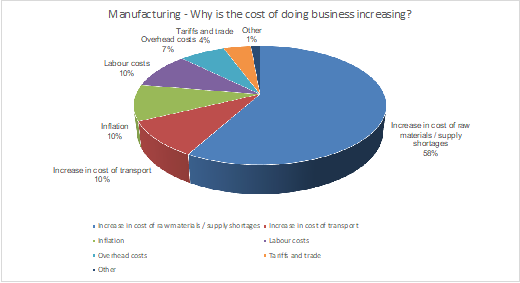White Paper
Enterprise Leaders Concerned About Meeting Growth Goals
Contact Us
In order to address spiraling cost pressures caused by surging inflation and commodity prices, business leaders are looking towards automation solutions. The recent geopolitical conflict in Eastern Europe has significantly disrupted commodities markets, compounding already heightened inflation levels and seeing price points rise in 2022 and beyond. To understand the true impact for businesses, SS&C Blue Prism commissioned a study of business leaders, which found that 73% of enterprise organizations have seen significant cost increases in the last year, with manufacturing hit the hardest.
The “Productivity Squared” research interviewed over 1,000 business decision-makers[1] and found that over the past 12 months, the average cost of doing business has risen by 9%. However, the study also found that these economic shifts are heralding a new era of work.
Industries are reshaping operations and are looking for alternatives to protect their futures and those of their employees and customers. In the face of drastically reduced margins, 78% of business leaders are turning to the power of advanced technologies, like artificial intelligence (AI) and Intelligent Automation, to help address the rising costs of business operations, talent shortage issues and economic shocks.

Despite almost half of businesses surveyed (47%) predicting that geopolitical events will negatively impact their growth, organizations remain positive and financially healthy, with the overwhelming majority (88%) expecting growth in 2022 and 2023. Digital transformation helped many businesses maintain growth during the pandemic-induced remote working model, with two-thirds (67%) reporting productivity increases in the last 12 to 18 months.
Still, half of companies (50%) say maintaining current productivity levels is an issue and 71% are struggling with talent attraction and retention as the labor market continues to reel from the “Great Resignation”. In the face of such conditions, decision-makers (69%) are planning to utilize RPA & IA strategies to relieve productivity pain points and find opportunity amidst strife. However, only 11% are certain about their organization’s strategy, showing concerns about poor implementation (59%), coordination strategy (40%) and legacy technologies (27%).

This study shows the importance of automation to the future of industry. It’s not only about achieving competitive edge, but also about long-term viability. It’s about automating what you can and using people where you should – embracing the “power of two” to bring about your organization’s goals and deliver the best to your employees, customers and stakeholders. The future of work is a collaboration between human workers and digital workers, leveraging the power of IA to drive innovation, growth and fulfillment. This study is just further evidence that what’s coming is not just an incremental increase in productivity, it’s productivity squared."Eric Tyree SVP of AI and Innovation, SS&C Blue Prism
For those companies that do put in place a successful strategy, the rewards of IA implementation can be significant. Santander Group is just one example of an organization that was able to reduce its employee onboarding process – from six weeks to only two days. This saved the company countless hours and improved employee satisfaction, which boosted talent retention and attraction. Global dairy company Fonterra also found success when it automated 38 dairy inventory checks, reducing the process time by 92% and addressing the company’s supply chain waste issues due to long inventory checks.
With the right automation partner, IA can be a launchpad for innovation and unification. It can facilitate employee upskilling while promoting process efficiencies – addressing talent barriers without holding up progress. As human workers are upskilled, automation software can be more deeply integrated. This empowers human employees to focus increasingly on fulfilling work, driving productivity gains as digital and human workers deliver on company goals and aspirations. The agility that gives an organization means it can be prepared to face any challenges or changes.
To read further insights download the full report.
[1] Research carried out in February 2022, with 1,005 business decision-makers in enterprise organizations spanning financial services, government, healthcare, and manufacturing sectors. Respondents were based in the UK, US, Ireland, France, Spain and Germany.
If your network blocks YouTube, you may not be able to view the video on this page. In this case, please use another device. Pressing play on the video will set third-party YouTube cookies. Please read our Cookies Policy for more information.